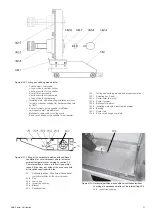
ABB Power Distribution
59
Checking of the readiness for operation can
be carried out as follows:
a) Load-dependent functional test with
controllable primary current injection of the
relevant instrument transformer. At current
rise:
1. to approx. 70% of the rated instrument
transformer current, the fan must start,
and
2. to 80 % of the rated instrument
transformer current, the fan must have
reached the required minimum air flow.
Corresponding monitoring/signalling by
the wind vane with microswitch.
b) Basic checking with temporary operation of
the centrifugal fan with an external power
supply of 220 V AC.
c) In both cases, check for unimpeded normal
running of the fan and listen for any unusual
bearing noise. Remove any dirt on the fan
rotor.
d) Check the unimpeded function of the wind
vane and microswitch by starting the fan
several times.
e) The wiring to the removable horizontal
partition 20 can be disconnected behind
the right-hand side duct cover 43.4 (figure
3/13). Observe the circuit diagram and
carefully reconnect the wiring on
completion.
Caution:
instrument transformer circuit.
• With regard to the switching devices, their sepa-
rate Instruction manual should be observed.
• Check all switchgear accessories and auxiliary
facilities (e.g. storage batteries).
• No external discharge may occur on the
surfaces of equipment at operating voltage. This
can, for example, be detected by characteristic
noises, a clearly perceptible smell of ozone, or
visible glowing in the dark.
• Visual checking of the contact system. We
recommend to turn alternately the contact
system in order to clean the inner contact points
of the contact system.
The contact points should be cleaned if signs of
unperminable overheating (discoloured surface)
are visible (see section 7.4).
• If irregular conditions are detected, then cor-
responding repair measures should be initiated.
7.3
Servicing
If, on the occasion of an inspection in accordance
with 7.2, the necessity of cleaning measures has
been established, proceed as follows:
• Before cleaning, where required, the working
area must be switched off and secured against
reconnection in accordance with the „Safety
Regulations“ specified by DIN VDE/IEC.
• Cleaning the surfaces in general:
– Weakly adhering dry dust deposits with a soft
dry cloth.
– More strongly adhering grime with mildly
alkaline household cleanser or with Rivolta
BWR 210.
• Cleaning insulating surfaces and conductive
components:
– Minor pollution with Rivolta BWR 210.
– Strongly adhering pollution with Cold cleanser
716.
• Observe the manufacturers’ directions and in
particular ABB Instruction manual BA 1002/E
and BA 1006/E on safety at work.
• Wipe down after cleaning, using clean water,
and dry properly.
• Should external discharges occur as a result of
condensation, application of a thin silicone film
on the surface concerned is often effective as a
temporary remedy. It is advisable to request
advice from the ABB after-sales service
department on permanent solutions to such
unusual problems.
7.4
Repair
7.4.1
Switchgear in general
Repair of surface damage:
• Carry out repair work immediately after a defect
has been discovered.
• Completely remove all rust from damaged paint-
work areas on steel sheet and other steel parts
by mechanical means, e.g. with a wire brush.
Lightly grind the surrounding paint coat and care-
fully degrease the entire area. Then immediately
apply an anti-rust primer and, after an appropriate
hardening time, apply the top coat. Only use
suitable and compatible paint products.
Apply the top coat in standard colour RAL 7035,
or the relevant special colour.
Summary of Contents for UniGear ZS1
Page 66: ...ABB Power Distribution 67 ...










































